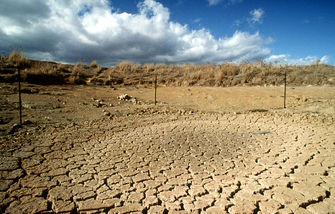« Prev Next »

Known as the "breadbasket of the world", the U.S. alone exports more corn, wheat, and soybeans than any other country, and global food prices have rapidly escalated because of the crop shortage in America. Approximately 80 percent of the country's corn crops and 11 percent of its soybean crops have been affected. Major droughts in the past three years alone have collectively caused more than ten billion dollars in losses of crops in the U.S. As it becomes increasingly clear that America's drought crisis is the world's problem, research is being conducted in the hopes of discovering a mechanism to increase drought tolerance in plants.

Although it is possible for crops to be sprayed with ABA to assist their survival during droughts, ABA is expensive to synthesize and inactive inside plant cells. However, the agrochemical mandipropamid, which has been widely used to control late blight of crops, seems to mimic the action of ABA in engineered crops. Researchers in UC-Riverside worked with Arabidopsis, a plant widely used in labs, and the tomato plant to synthetically develop a new version of these plants' ABA receptors engineered to respond to mandipropamid instead of ABA. When these drought-affected plants were sprayed with mandipropamid, they survived drought conditions by turning on the ABA pathway, which closed their stomatas to prevent further water loss.
This discovery proves that synthetic biological innovation allows for crop improvement and can support a growing world population. Ultimately, the mandipropamid agrochemical was repurposed for a new application by genetically engineering a plant receptor, and this is something that has not been done before. It is anticipated that this reprogramming strategy using synthetic biology will allow scientists to control other plant traits, such as growth rates or disease resistance. Although this seems to be very promising for crop shortages caused by drought conditions, it is still a while away before mandipropamid and genetically engineered plant receptors can be applicable for all plants affected by drought.
References:
The Atlantic. America's Drought is the World's Problem (2009).
Phys.org. Researchers examine how to minimize drought impact on important food crops (2015).
Phys.org. Scientists reveal secrets of drought resistance (2009).
Phys.org. Scientists reveal underpinnings of drought tolerance in plants (2015).
Phys.org. World's largest drought resistance experiment on chickpeas under way at UVA (2014).
Finkelstein, R. Abscibic Acid Synthesis and Response. Arabidopsis Book. 2013; 11
ScienceDaily. Scientists reprogram plants for drought tolerance (2015).
Zhu, J. K. Salt and Drought Stress Signal Transduction in Plants. Annu Rev Plant Biol. 2002; 53: 247-73
Image Credits:
1. The Plant Drought Image is by Wikipedia user CSIRO and is distributed via Wikimedia Commons under a CC-BY license.
2. The ABA and PYR1 Molecule Complex is from Unnatural agrochemical ligands for engineered abscibic acid receptors by Rodriguez and Lozano-Juste and is distributed by Cell.com.






















